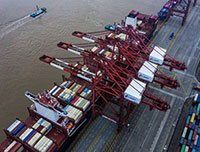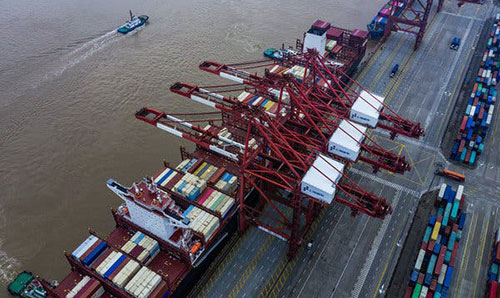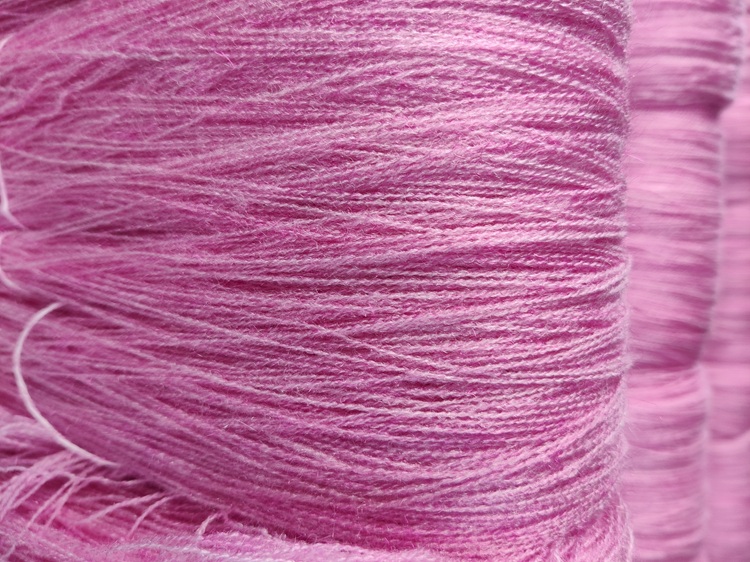FW
The US is set to impose 25 percent duties on imports from the European Union (EU), including a considerable amount of apparel from the U.K. According to the UK Fashion and Textile Federation (UKFT), the list of products that will face a 25 percent tariff will range from cashmere jumpers to swimwear. This is in addition to the normal duties that will apply. They will be introduced on October 17, 2019 and will apply even if the UK leaves the EU.
For the year to date through July, the US imported $60.94 million in apparel from the UK, an increase of 9.83 percent from the prior-year period, according to the Commerce Department’s Office of Apparel & Textiles (OTEXA). Wool apparel imports rose 13.94 percent to $19.36 million. UK apparels already face among the highest tariffs charged on any product and adding more tariffs will inject more costs into the system which will result in reduced sales, higher prices or lost jobs.
The EU Trade Commissioner Cecila Malmstrom has termed these tariffs “short-sighted and counterproductive and expressed a desire to find a fair settlement.
The Annual Bangladesh Business Forum, held on October 2, 2019 in Dhaka focused on sustainability in the RMG industry. The theme of the forum was ‘Driving Sustainable Change.’ It was organised by the Better Work Bangladesh (BWB) program, a joint collaboration between the International Labour Organization (ILO) and the International Finance Corporation (IFC).
Discussions at the forum centered on the need for a globally competitive garment industry supported by improved labor market governance, effective social dialogue and responsible sourcing practices to ensure decent work and generate long-term prosperity for the industry. A number of speakers also highlighted ongoing issues facing the industry, including how BWB and its brand partners can continue to address gender and OSH non-compliances.
Over 350 RMG stakeholders, including representatives from the government, employers’ and workers’ organisations, development partners, global brands and retailers, manufacturers, civil society and academia attended the high-level event.
Through its core services— assessments, advisory and training—Better Work works to improve compliance practices and deliver beneficial outcomes to both factories and workers.
The Better work program currently works with more than 1,700 factories and 2.4 million workers in eight countries and engages 60 global brands and retailers. Better Work brings together all levels of the garment industry to improve working conditions and respect for labor rights for workers and boost the competitiveness of apparel businesses.
Global fashion exports in the last decade increased by 35.1 per cent while global trade increased 26.4 per cent, says the World Trade Organization. India registered the strongest performance in its international clothing trade during this period followed by Brazil and other Asiatic countries excluding China. Exports by the United States increased 28.6 per cent between 2007 and 2008, those by Japan increased by 20.1 per cent and the European Union by 33.5 per cent. China, that entered the WTO in 2001, increased its garment exports by 93.3 per cent during this period. Middle East and Australia also positioned high in the list, with rises near 100 per cent.
Restrictive measures of world trade registered exceptionally high levels between October 2019 and mid-2019. The focus of the global fashion sector is turning to the environment, and the industry’s impact and role. Fashion falls just behind energy production and food as the most polluting industry, with a disturbingly large ecological footprint. It is incredibly wasteful. It takes at least 10,000 liters of water to produce a kg of cotton (enough for a pair of jeans and a shirt) and more than 75 per cent of clothes go to landfill.
Amouve, based in Bangalore, helps organic farmers become sustainable and profitable. The cotton the start-up uses to make bed sheets, pillow covers, cushion covers, comforters and quilts is sourced from about 500 farmers, who are part of a cooperative. Middlemen are cut out. Cotton from organic farms goes to the factory and is woven into soft linen that gets softer with each wash. In this way Amouve provides eco-friendly bedding options to consumers. The company works with farmers in Telangana and surrounding regions and sells only single-ply 300 thread count sheets and its towels are super soft in 700 grams per square meter, crafted with a low-twist proprietary weave.
Amouve has stepped into offline retail and is present at Danube Home in Hyderabad. The plan is to be present in five more stores in the next one year and achieve a year-on-year growth of 25 per cent.
Most of the linen available in the market is plastic packed with no information on what the material is and conventional cotton uses pesticides, which are not good for the skin. On the other hand, polyester fabric releases plastic microfibers into waterways and these persist indefinitely, contaminating lakes and oceans, getting ingested by animals, and indirectly by humans.
"The US-China trade war is threatening the health of global economy as world trade is deteriorating rapidly. During the current year, trade is expected to expand by only 1.2 per cent, its weakest growth since 2009. The WTO has warned that intensifying trade conflicts may pose a direct threat to jobs and livelihoods, besides discouraging companies from expanding and innovating. Two of the world’s largest economies, the United States and China —witnessed a rapid decline in their commercial activities in the recent months, a development intensified by the tariffs they imposed on each other’s exports which not only raised their business costs but also discouraged investors."
 The US-China trade war is threatening the health of global economy as world trade is deteriorating rapidly. During the current year, trade is expected to expand by only 1.2 per cent, its weakest growth since 2009. The WTO has warned that intensifying trade conflicts may pose a direct threat to jobs and livelihoods, besides discouraging companies from expanding and innovating. Two of the world’s largest economies, the United States and China —witnessed a rapid decline in their commercial activities in the recent months, a development intensified by the tariffs they imposed on each other’s exports which not only raised their business costs but also discouraged investors.
The US-China trade war is threatening the health of global economy as world trade is deteriorating rapidly. During the current year, trade is expected to expand by only 1.2 per cent, its weakest growth since 2009. The WTO has warned that intensifying trade conflicts may pose a direct threat to jobs and livelihoods, besides discouraging companies from expanding and innovating. Two of the world’s largest economies, the United States and China —witnessed a rapid decline in their commercial activities in the recent months, a development intensified by the tariffs they imposed on each other’s exports which not only raised their business costs but also discouraged investors.
No-deal Brexit threatens trade growth across Europe
European trade is affected by the fear of Great Britain exiting the European Union without a proper deal governing future commerce across the English Channel. Even an American company closed down in September. This was the second company to shut shop in the US. It also affected the reading on the Institute for Supply Management’s manufacturing index which recorded its lowest reading since June 2009. Not only did stocks drop but money also shifted into Treasury bonds which indicated investor’s willingness to accept the prospect of smaller rewards in exchange for refuge from risk.
governing future commerce across the English Channel. Even an American company closed down in September. This was the second company to shut shop in the US. It also affected the reading on the Institute for Supply Management’s manufacturing index which recorded its lowest reading since June 2009. Not only did stocks drop but money also shifted into Treasury bonds which indicated investor’s willingness to accept the prospect of smaller rewards in exchange for refuge from risk.
Another effect of the trade war was the significant decline in prices. The exchange rate of the dollar also increased significantly making American goods more expensive. President Trump blamed Jerome H Powell, Chairman of the Federal Reserve Bank for this increase. Trump also accused the Central Bank of keeping interest rates too high. Triggered by these concerns, the bank dropped its interest rates twice this year after raising them four times in 2018.
Bleak economic outlook
Few people believe President Trump has the power to restore economic vigor himself. Even the WTO forecasts trade will grow only 2.7 percent next year. When the organisation released its last forecast in April, its sentiments were buoyed by hopes that Washington and Beijing were nearing a deal to resolve their trade disputes.
However, in September, Trump increased tariffs on $112 billion worth of Chinese imports, threatening American consumers with higher costs for shoes, apparel and electronics. As China slapped retaliatory tariffs on $75 billion of American imports,
Though the president last month delayed a planned increase in tariffson $250 billion worth of Chinese goods by two weeks, experts are skeptical that an agreement will be struck, amplifying concerns about a range of indicators that the global economy is weakening — including a slowdown in freight and quieter factories.
Impact on other countries
The trade war is also threatening other economies like Singapore, Japan, South Korea and Taiwan who have suffered diminished sales due to a slowdown in China. Germany noted a slowdown in factory orders in September as Chinese companies reduced purchases of German-made machinery. German companies are threatened by tariffs on German cars sold in the United States. This is dampening consumer spending in the country, contributing to weakness in other European economies like Spain and Italy.
A potent risk that could threaten future trade in Europe is the exit of Britian from the EU without a proper deal. The situation could further compound the uncertainty that Europe faces over its future trade dealings. Prime Minister Boris Johnson, who has vowed to exit EU on Oct. 31, with or without a deal, has demanded a scrapping of a provision negotiated by his predecessor, Theresa May, to prevent the reimposition of a hard border separating Northern Ireland from the independent Republic of Ireland to the south.
The British Parliament also adopted emergency legislation last month that would force Johnson to seek an extension of the deadline if he failed to strike a deal. However, none of this is tempting companies to invest in Britian. The spectacle of Britain getting poorer and stuck in the Brexit quagmire is feeding into the weakness of trade growth for other European countries.
The United States will soon impose tariffs on European goods. The US believes subsidies paid by certain EU member states to French aircraft maker Airbus harmed the US industry. In the dispute, which began in 2004, the United States argued that the EU gave Airbus billions of dollars of launch aid that resulted in an unfair advantage for Airbus. Specifically, the United States asserted that the aid allowed Airbus to gain market share in Europe, Australia, China, South Korea, and elsewhere.
The bulk of the tariffs will be applied to imports from France, Germany, Spain, and the United Kingdom—the four countries said to be responsible for the subsidies. The range will cover civil aircraft, agricultural and other products, sweaters, pullovers and sweatshirts in wool, cashmere, cotton and manmade fibers, performance outerwear, wool suits, women’s and girls’ cotton nightwear, swimwear, and cotton bed linen and blankets.
The WTO is expected to authorize the countermeasures. The tariffs won’t yet provoke a trade war because the EU is not allowed to retaliate against WTO-authorized countermeasures. Meanwhile there have been rumblings that the US might be targeting Vietnam. The Southeast Asian country has seen some benefit from the US-China trade war as apparel firms look elsewhere–with Cambodia and Bangladesh in the running, too–for sourcing and manufacturing production.
US demand for apparel is forecast to rise 1.7 per cent annually through 2023. The ongoing population expansion will drive gains, and increase personal income, driving spending on luxury, environmentally friendly, and name-brand items. An ongoing athleisure trend will boost demand for higher priced apparel made from performance materials. Growing raw material costs and the threat of tariffs on clothing from China will force apparel manufacturers to lower margins or raise prices.
However, the mature market for clothing and intensifying competition from a variety of retail channels will limit volume growth and price increases. In addition, more consumers are purchasing apparel (especially athletic apparel) wearable for a variety of activities in diverse social contexts, such as fitness centers, workplaces, and restaurants, reducing the number of garments needed throughout the day.
US apparel prices are going up. From the raw materials and inputs that go into fibers and fabrics to the cost of labor and logistics, increased costs are leading to price hikes. Already, footwear and apparel are some of the most highly taxed products in the US, reaching as high as 37.5 per cent. The impact could challenge consumer spending in an already tough retail market. Retail apparel prices increased 1.1 per cent in June, the first gain in four months.
These jackets are light weight, between five kg and ten kg, and are of world class quality. The price of these jackets ranges from Rs 70,000 to Rs 80,000, considerably lower than the price of the jackets that were being procured earlier. The jackets have a dynamic weight distribution system, which makes it feel half its actual weight. They also have an easy to open and release system to ensure that the jawans can easily wear and remove the jackets. The jackets also allow the jawan to use his weapon with ease while getting a 360 degree protection from bullets. India is exporting these jackets. Maximum areal densities for soft armor panel and hard armor panel have been specified for these jackets.
With this India joins a select group of nations such as the US, UK and Germany that have their own standards for bullet-resistant jackets. The jackets have been made using standards set by the Bureau of India Standard. The standard is expected to fulfil the long-pending demand of the Indian armed forces, paramilitary forces and state police forces and assist them in streamlining their procurement process. This standard has been formulated following the directions of Niti Aayog and the ministry of home affairs.
American & Efird (A&E) has released a new line of 100 per cent recycled, industrial sewing threads. The launch of this product line is driven by the company’s commitment to sustainability and a surge of sustainable product pledges and commitments by prominent brands and retailers around the world. The company is known in the industry for sustainable, ethically-made sewing threads.
A&E is a manufacturer of industrial and consumer sewing threads. Known for its leadership role in innovation, product quality, and sustainability, A&E supports many of the world’s top industrial and consumer brands with thread products that require strict quality and performance. Through its global network, A&E’s products are manufactured in 22 countries, distributed in 50 countries and sold in over 100 countries. The textile thread manufacturer achieved its initial targets for zero-waste-to-landfill in 2015. American & Efird has also launched a new recycled polyester sewing thread. This is designed especially for athletic wear and high-performance apparel. The new thread is derived from recycled post-consumer plastic bottles and aims to provide textile manufacturers within the performance apparel, active wear, athleisure, and intimate apparel markets a recycled alternative to existing sewing threads. The air-entangled sewing thread is made with Repreve recycled polyester, a brand of US yarn supplier Unifi.
Carlos Inacio will head Primark in Spain. Inacio began his career at Primark in 2009 as the area director of the group in Portugal. Subsequently, he was promoted to commercial director in Spain and Portugal and was appointed in 2018 as sales director for Spain. The executive, who has developed part of his career at H&M, has been in the structure of the Irish group for nearly eleven years.
Spain is the second largest market for Primark by revenue. The Irish low-cost fashion retailer has 45 stores in Spain. There are 185 stores in the United Kingdom and 27 stores in Germany. Primark ended 2018 with a five per cent growth in sales in Spain. With a workforce of 6,295 employees in the Peninsula and the Canary Islands, the group increased its profit in Spain by 57.6 per cent compared to the previous year.
Primark is the seventh largest fashion retailer in the world. The company’s operating profit stood at a billion dollars last year. Primark hopes to close the 2019 fiscal year with a four per cent growth in revenue. Spain will continue to be one of the main priorities of Primark’s expansion this year. France and Spain will cover the bulk of the group’s openings, adding between the two markets a total of 19 new stores, in addition to extensions and relocations.












